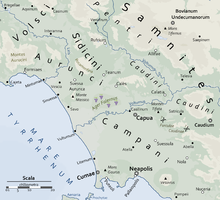Casilinum
Casilinum was an ancient city in Campania . It was 3 miles northwest of ancient Capua , on the site of today's Capua . The location of Casilinum at the intersection of the Via Appia and the Via Latina at the crossing over the Volturnus river through a still existing bridge with three arches made the city of considerable strategic importance during the Roman Republic .
The pre-Roman city was certainly dependent on neighboring Capua and was located on the left bank of the river, which flowed around three sides of Casilinum. The ruins of the pre-Roman city could be found 25 meters below today's ground level. The Romans expanded the city to the right of the bank.
During the Second Punic War , Casilinum was founded in 217 BC. First occupied by Quintus Fabius Maximus Verrucosus . Hannibal conquered the city after the troops of Praeneste and Perusia occupied it in the winter of 216/5 BC. Had heroically defended against the Carthaginians. 214 BC BC the Romans recaptured Casilinum; then they set it up as a base of operations to fight the rebellious Capua. It was then that Casilinum lost its independence and became a praefectura .
Caesar founded A colony in the city, which 44 BC Was renewed by Marcus Antonius . The veterans settled here were the first to join the side of his adopted son Octavian after Caesar's death (44 BC) .
It appears that Casilinum was united with Capua some time before Vespasian . The name of Casilinum no longer appears in Pliny 's list of independent parishes . In his Naturalis historia 3, 70 he speaks of morientis Casilini reliquiae . Only the intersection of the important streets has meant that the name has not sunk into insignificance.
After the destruction of old Capua by the Saracens in 840, the Lombard bishop Landulf of Capua decided in 856 for Casilinum as the place for the new foundation of Capua ("Capua nova").
literature
- Umberto Pappalardo : Casilinum. In: The New Pauly (DNP). Volume 2, Metzler, Stuttgart 1997, ISBN 3-476-01472-X , Sp. 1002.
- Christian Hülsen : Casilinum. In: Paulys Realencyclopadie der classischen Antiquity Science (RE). Volume III, 2, Stuttgart 1899, column 1651.
Remarks
- ^ Titus Livius , Ab urbe condita 22, 15.
- ↑ Livius, Ab urbe condita 23, 17 and 19; Strabon , Geographika 5, 249; among others
- ^ Livy, Ab urbe condita 24:19 .
- ↑ Cicero , Philippica 2, 101; Appian , Civil Wars 3, 40.
- ↑ Cicero, Epistulae ad Atticum 16, 8, 1; Velleius Paterculus , Historia Romana 2, 61; Appian, Civil Wars 3, 40.

